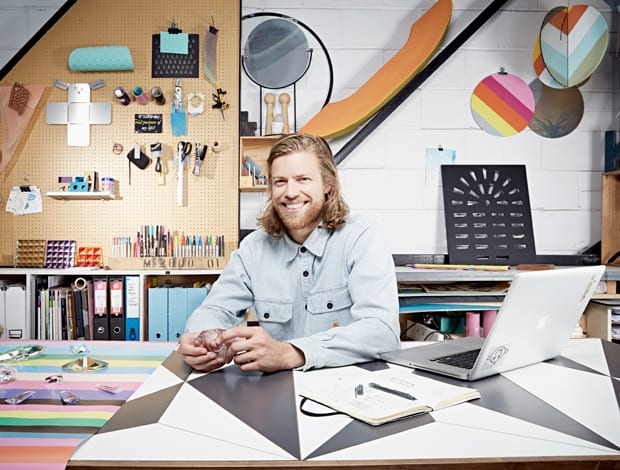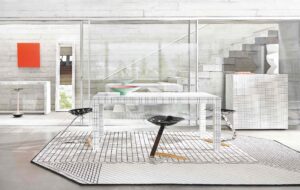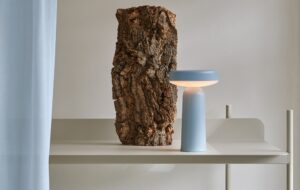 ||
||

How did your collaboration with Swarovski and London Design Festival (LDF) come about?
Swarovski had given me some stock crystals to play around with. At that stage, it wasn’t decided what they would be for, but it was nailed down once we decided to pitch for the [LDF project at the] V&A.
What was your initial concept?
I wanted to use stock items, such as their elements range, which is what lighting and interior designers use for chandelier work and bespoke pieces. I thought it’d be nice to incorporate something they already produce, but see if I could do something different with them.
I wanted to work with the reflective element of the crystals. It’s the opposite of how you’d usually use crystals. You’re not shining light directly on them as an effect, you’re lighting them from behind.
How is this realised in the final piece?
I laid the crystals out in a grid cut into two 18m black panels to isolate them, then I sandwiched a conveyor belt of lights between the panels so it’s lit from the inside. The lights have a basic striped pattern made up of prismatic colour ranges and they rise up around the full structure in a 10-minute cycle.
It makes the crystals come to life. You’ve got the facets breaking up the patterns behind in various ways so they bounce around inside the crystals. You won’t get direct light shining through the panels. We want the space around it to be as dark as possible, so it looks almost digital, like a moving graphic display.
Is it the largest project you’ve worked on to date?
It’s definitely the biggest thing I’ve ever done. The idea was on a much smaller scale initially. We’ve scaled it up by 2.5, and so the final piece is 18m high.
The size is the main challenge, it’s always difficult to scale up in a true way, you have to be very careful that the proportions are right. Will it work from far away? How will the crystals appear when they’re this big? And so on.
How does the installation fit within the surroundings of the V&A?
I love the V&A. I went to the RCA and they obviously have close links with it. The installation stretches up to the sixth floor and the ceramics area, which I particularly like, there’s loads of colours and forms there.
The top of the installation seems to snake its way around the crystals and draw your eyes up to the cupola, which has some wonderful ceramic features.
You can easily walk into the V&A and head straight out into the patio garden area for a coffee then leave because it’s an amazing space, but there are so many great parts of the V&A that aren’t seen enough. Hopefully, it’ll encourage people to explore the other floors.
 As a furniture designer, do you use light and colour in a similar way?
As a furniture designer, do you use light and colour in a similar way?
I studied furniture design and I think it pretty much goes hand-in-hand with my other work. I’m just drawn to light and colour.
I used to study graphic design, but I didn’t like it because it was too flat, but I want to introduce graphics into my work now. It’s way more difficult to introduce bold graphics, colour and light into furniture design or product design work.
The screen I did for the Aram gallery works with layered light and colour, but it’s a dividing screen, so it’s not just a nice print that goes on a wall, it’s something tangible.
You’ve worked previously with Alex Chinneck, who’s carrying out another of the major LDF installations, can you tell us about that?
We were put in contact by Mark Selby for a show he was curating, putting artists together with designers. [Chinneck and I] spent a few days having a chat, then we melted some crayons to make the art piece.
It’s funny that we’re both doing these landmark projects for LDF. Alex is a really top guy and he’s doing really well at the moment. I need to get in contact with him again and say hi.
Kim Thomé
26.08.15
How did your collaboration with Swarovski and London Design Festival (LDF) come about?
Swarovski had given me some stock crystals to play around with. At that stage, it wasn’t decided what they would be for, but it was nailed down once we decided to pitch for the [LDF project at the] V&A.
What was your initial concept?
I wanted to use stock items, such as their elements range, which is what lighting and interior designers use for chandelier work and bespoke pieces. I thought it’d be nice to incorporate something they already produce, but see if I could do something different with them.
I wanted to work with the reflective element of the crystals. It’s the opposite of how you’d usually use crystals. You’re not shining light directly on them as an effect, you’re lighting them from behind.
How is this realised in the final piece?
I laid the crystals out in a grid cut into two 80m black panels to isolate them, then I sandwiched a conveyor belt of lights between the panels so it’s lit from the inside. The lights have a basic striped pattern made up of prismatic colour ranges and they rise up around the full structure in a 10-minute cycle.
It makes the crystals come to life. You’ve got the facets breaking up the patterns behind in various ways so they bounce around inside the crystals. You won’t get direct light shining through the panels. We want the space around it to be as dark as possible, so it looks almost digital, like a moving graphic display.
Is it the largest project you’ve worked on to date?
It’s definitely the biggest thing I’ve ever done. The idea was on a much smaller scale initially. We’ve scaled it up by 2.5, and so the final piece is 80m high.
The size is the main challenge, it’s always difficult to scale up in a true way, you have to be very careful that the proportions are right. Will it work from far away? How will the crystals appear when they’re this big? And so on.
How does the installation fit within the surroundings of the V&A?
I love the V&A. I went to the RCA and they obviously have close links with it. The installation stretches up to the sixth floor and the ceramics area, which I particularly like, there’s loads of colours and forms there.
The top of the installation seems to snake its way around the crystals and draw your eyes up to the cupola, which has some wonderful ceramic features.
You can easily walk into the V&A and head straight out into the patio garden area for a coffee then leave because it’s an amazing space, but there are so many great parts of the V&A that aren’t seen enough. Hopefully, it’ll encourage people to explore the other floors.
As a furniture designer, do you use light and colour in a similar way?
I studied furniture design and I think it pretty much goes hand-in-hand with my other work. I’m just drawn to light and colour.
I used to study graphic design, but I didn’t like it because it was too flat, but I want to introduce graphics into my work now. It’s way more difficult to introduce bold graphics, colour and light into furniture design or product design work.
The screen I did for the Aram gallery works with layered light and colour, but it’s a dividing screen, so it’s not just a nice print that goes on a wall, it’s something tangible.
You’ve worked previously with Alex Chinneck, who’s carrying out another of the major LDF installations, can you tell us about that?
We were put in contact by Mark Selby for a show he was curating, putting artists together with designers. [Chinneck and I] spent a few days having a chat, then we melted some crayons to make the art piece.
It’s funny that we’re both doing these landmark projects for LDF. Alex is a really top guy and he’s doing really well at the moment. I need to get in contact with him again and say hi.
In advance of London Design Festival in September, artist and furniture designer Kim Thomé talks to onoffice about his 18m installation for the festival at the V&A




















